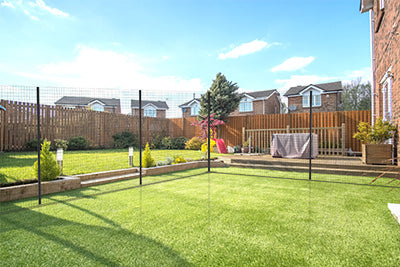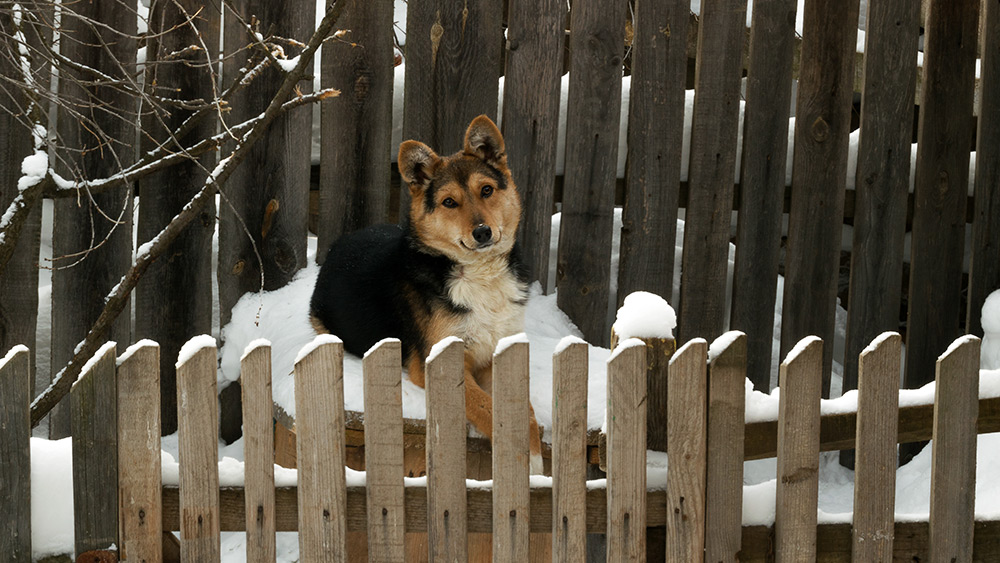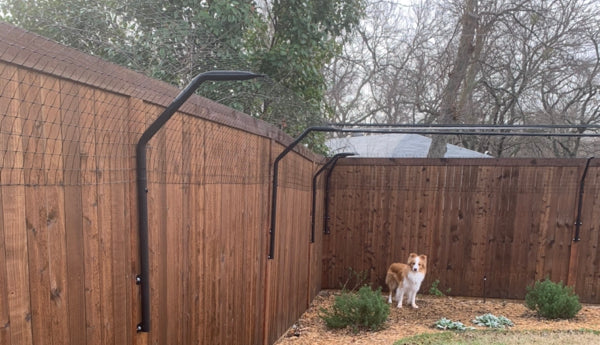Are you looking to create a safe outdoor space for your furry friends? Whether you have a dog, a cat, or even a pet rabbit, it’s important to have a secure fence that keeps them in and provides protection from outside dangers. In this article, we’ll explore the topic of fences and pets in detail and share some valuable information that will help you create a safe and enjoyable outdoor environment for your beloved animals.
We’ll cover everything from the different types of fences that are suitable for pets to the features you should consider when choosing a fence. We’ll also discuss the proper installation and maintenance of fences and provide tips on how to train your pets to stay within the designated area. By the end of the article, you’ll have a better understanding of how to create a safe outdoor space for your pets and ensure their well-being while enjoying the great outdoors. So, let’s dive in and learn more about fences and pets!
Fences and Pets: Creating a Safe Outdoor Space
Fences play a crucial role in creating a safe outdoor space for pets. Whether you have a playful pup or a curious cat, having a fence can provide numerous benefits for your furry friends. From keeping them safe from external dangers to providing privacy and security, there are plenty of reasons why having a fence is essential for pet owners.

Keeping Pets Safe from External Dangers
One of the primary benefits of having a fence for your pets is keeping them safe from external dangers. When your pets have access to an open outdoor space, they can be exposed to various risks such as traffic accidents, encounters with aggressive animals, or consuming toxic substances. By having a fence around your yard, you provide a secure environment where your pets can roam freely without the fear of being harmed.
Preventing Pets from Wandering Off
Pets are naturally curious creatures, and if left unattended, they may wander off and get lost. This is where a fence comes in handy, acting as a physical barrier that prevents your pets from wandering off into unfamiliar territory. With a well-constructed fence, you can have peace of mind knowing that your pets are safely contained within your property.
Providing Privacy and Security for Pets
Just like humans, pets also appreciate their privacy. Having a fence around your yard gives your pets a designated space where they can enjoy some alone time, play, or relax without the prying eyes of strangers. Additionally, a fence enhances security by keeping potential intruders out, creating a safe haven for your pets.
Choosing the Right Fence for Pets
Now that you understand the importance of having a fence for your pets, it’s crucial to consider various factors when choosing the right fence. Here are some considerations to keep in mind:
Considerations Based on Pet Size and Breed
Different pets have different needs when it comes to fences. Smaller dogs or cats may require a fence with narrower gaps between pickets to prevent them from squeezing through. On the other hand, larger breeds may need a taller fence to prevent them from jumping over. Understanding your pet’s size and behavior can help you choose the appropriate fence design.
Materials and Durability
When selecting a fence for your pets, durability is key. You need a fence that can withstand the elements and the wear and tear caused by your pets. Materials such as vinyl, aluminum, and wood are popular choices due to their strength and longevity. Consider the maintenance requirements and lifespan of each material before making a decision.
Height and Design Features
As mentioned earlier, the height of the fence plays a vital role in containing your pets. However, it’s also important to consider additional design features that can enhance the effectiveness of the fence. For example, a fence with a curved or inward-leaning top can discourage pets from attempting to jump over. Additionally, adding a sturdy gate will provide easy access for both you and your pets.

Budget-Friendly Fence Options for Pet Owners
While the safety of your pets is a top priority, it’s also important to consider your budget when choosing a fence. Here are some affordable options for pet owners:
Affordable Materials for DIY Fence Installation
If you’re a handy pet owner, you may consider installing a fence yourself. Choosing cost-effective materials such as chain-link fencing or pressure-treated wood can help keep the costs low. It’s important to research proper installation techniques and consult with experts to ensure your DIY fence meets safety standards.
Cost-Effective Maintenance and Repairs
When selecting a fence, consider the long-term maintenance and repair costs. Some fences require regular painting or staining, while others may need occasional repairs. Opting for low-maintenance materials or investing in a warranty can help minimize future expenses.
Alternative Fencing Solutions
If traditional fencing is beyond your budget, there are alternative solutions to consider. Pet owners can explore temporary fencing options like portable pet fences or playpens. These lightweight and easy-to-install solutions provide a safe enclosure for your pets without breaking the bank.
Training Pets to Adapt to the Fence
Once you have installed a fence, it’s essential to train your pets to adapt to their new outdoor space. Here are some tips for a successful transition:
Introduction to the Fenced Outdoor Space
Allow your pets to gradually explore the fenced outdoor space with supervision. Start with short periods of time and gradually increase their exposure. This will help them become familiar with the boundaries and understand that this is their designated area.
Positive Reinforcement Techniques
Reward your pets with praise, treats, or playtime whenever they stay within the fenced area. Positive reinforcement will help them associate the fenced space with positive experiences, encouraging them to stay within the boundaries.
Addressing Anxiety or Fear Associated with Fences
Some pets may develop anxiety or fear toward fences, especially if they have had negative experiences in the past. Slowly introduce them to the fence and monitor their behavior. If necessary, seek professional help or consult a veterinarian for guidance on overcoming fear or anxiety.

Common Challenges and Solutions for Pet Owners with Fences
While fences provide numerous benefits, pet owners may encounter certain challenges. Here are some common issues and possible solutions:
Digging or Jumping Over the Fence
If your pets have a tendency to dig under or jump over the fence, there are various solutions to address this behavior. You can reinforce the bottom of the fence with additional materials or create a barrier underground to prevent digging. For jumpers, consider adding an extension to the top of the fence or using anti-climbing devices.
Aggression Towards Strangers near the Fence
Some pets may display aggressive behavior towards strangers passing by the fence. Proper socialization and training can help address this issue. Additionally, you can consider visual barriers such as landscaping or privacy slats to minimize your pet’s exposure to external stimuli.
Preventing Fence-Chewing Behavior
Pets, especially puppies, may chew on the fence out of boredom or teething. Providing plenty of toys and engaging in exercise and playtime can redirect their chewing behavior. It’s also important to choose a fence material that is resistant to chewing, such as vinyl or metal.
Implementing Safety Measures within the Fenced Area
While the fence provides a secure outdoor space, it’s important to implement additional safety measures to ensure your pets’ well-being. Consider the following:
Creating Escape-Proof Entrances
Make sure the entrances and gates are secure and escape-proof. Use self-closing hinges, latches, or locks to prevent accidental escapes. It’s also important to check the integrity of the fence regularly to identify and fix any potential weak points.
Avoiding Toxic Plants in the Yard
When landscaping your yard, ensure that any plants or flowers within reach of your pets are non-toxic. Certain common plants can be harmful or even fatal to pets if ingested. Consult with a veterinarian or research pet-friendly landscaping options to create a safe environment.
Installing Adequate Shelter and Water Stations
Provide your pets with adequate shelter, such as a doghouse or covered space, where they can seek shade and protection from the elements. Additionally, ensure access to fresh water at all times, especially during hot weather.

Integrating Play and Exercise Spaces in the Fenced Area
A fenced outdoor space provides an excellent opportunity to create an engaging environment for your pets. Incorporate play and exercise areas to keep them mentally stimulated and physically active. Consider the following ideas:
Choosing Pet-Friendly Playground Equipment
Install pet-friendly playground equipment such as agility tunnels, ramps, or platforms that cater to your pets’ specific needs. These structures encourage exercise, obedience training, and socialization.
Creating an Agility Course
Set up an agility course within the fenced area, complete with obstacles such as hurdles, weave poles, and tunnels. Training your pets to navigate the course can be both mentally and physically stimulating.
Designing Interactive Toys and Activities
Introduce interactive toys and games that keep your pets entertained and active. Treat-dispensing toys, puzzle feeders, or balls can provide hours of fun. Regularly rotate the toys to prevent boredom.
Seasonal Considerations for Pets and Fences
The changing seasons bring new challenges and considerations for pet owners with fences. Here are some tips to ensure your pets’ safety throughout the year:
Winter Preparations for Outdoor Pets
During winter, provide your pets with adequate shelter and protection from the cold. Ensure that the fence is properly maintained, with no gaps or weak spots that may be compromised by snow or ice. Clear any snow or ice accumulation around the fence to prevent your pets from escaping or getting injured.
Summer Heat Safety Measures
In hot weather, it’s important to provide your pets with cool and shaded areas within the fenced space. Consider adding features like a covered patio or awning to protect them from the sun. Provide plenty of fresh water and avoid leaving pets outside during the hottest parts of the day.
Protecting Pets from Pests and Wildlife
Fences can help keep unwanted pests and wildlife out of your yard. Ensure that the fence is in good condition without any gaps or holes that could allow access to pests. Additionally, consider pet-safe pest control measures to protect your pets from ticks, fleas, and other outdoor parasites.

Common Fence Maintenance Tips for Pet Owners
Regular maintenance of your fence is essential to ensure its effectiveness and durability. Here are some common maintenance tips for pet owners:
Regular Inspections and Repairs
Inspect your fence regularly for any damage or weak points. Repair or replace any broken boards, loose pickets, or damaged sections promptly. Regularly check the gates, hinges, and latches to ensure they are functioning properly.
Cleaning and Stain Removal
Remove any dirt, grime, or debris from the fence to maintain its appearance and prevent premature deterioration. Use mild soap or fence cleaning solutions and rinse thoroughly. Consider applying a protective stain or paint to provide an additional layer of defense against the elements.
Weatherproofing and Sealing
Protect your fence from the elements by weatherproofing and sealing the wood or other susceptible materials. This will help prevent rot, warping, or discoloration caused by moisture and prolonged exposure to the sun.
Incorporating Pet-Friendly Features into Fence Design
To enhance your pets’ overall outdoor experience, consider incorporating pet-friendly features into the fence design. Here are some ideas:
Pet Doors and Windows
Installing a pet door or window within the fence allows your pets to have easy access to the outdoors even when the main gates are closed. This gives them the freedom to explore or take care of their business without constant supervision.
Shaded Areas and Resting Spots
Create shaded areas within the fenced space where your pets can relax and cool off during hot days. This can include adding covered seating areas, trees, or planting shrubs that provide natural shade.
Creating Safe Zones for Different Pets
If you have multiple pets with different needs, consider creating designated zones within the fenced area. Separating play and rest areas can help prevent conflicts or anxiety between pets.
Legal and Ethical Considerations of Fences for Pets
Before installing a fence, it’s crucial to consider the legal and ethical aspects that come with it. Here are some points to keep in mind:
Local Laws and Regulations
Research and familiarize yourself with the local laws and regulations regarding fences for pets. Some areas may have specific height requirements, setback rules, or restrictions on certain fence materials. Ensure that your fence complies with these regulations to avoid any legal issues.
Respecting Neighbor Boundaries and Privacy
When building a fence, be mindful of your neighbors’ boundaries and privacy. Communicate with them to ensure that the fence does not encroach on their property or obstruct their views. Consider installing privacy features or landscaping along the fence line to maintain a good relationship with your neighbors.
Environmental Impact of Fencing Solutions
Take into consideration the environmental impact of the fencing solutions you choose. Opt for eco-friendly materials and practices whenever possible. For example, using sustainably sourced wood or recycled materials can help minimize the environmental footprint of your fence.
Alternative Enclosure Options for Pets
While traditional fences are a popular choice, there are alternative enclosure options available for pet owners. These options may be suitable for specific situations or living arrangements. Consider the following alternatives:
Portable and Temporary Fencing Solutions
Portable pet fences or playpens are versatile options that can be easily set up and moved around. They are ideal for temporary outdoor spaces or when you need to confine your pet to a specific area temporarily.
Indoor Playpens and Enclosures
Indoor playpens or enclosures are perfect alternatives for pet owners who live in apartments or have limited outdoor space. These confined areas provide a safe play area where pets can exercise and play without the need for a traditional fence.
Leash and Tethering Considerations
In situations where fences are not possible or allowed, leash and tethering can be used as a temporary solution. However, it’s important to ensure that your pets have enough space to move freely and be comfortable. Supervision is crucial when using leash or tethering options to prevent entanglement or other safety hazards.
Fences as a Deterrent for Common Pet Problems
Having a fence can be an effective deterrent for common pet-related problems. Here are some issues that fences can help address:
Preventing Pet-Related Property Damage
Some pets may exhibit destructive behavior, such as digging up plants or scratching doors. A fence can confine your pets to a designated outdoor space, minimizing the risk of property damage.
Discouraging Digging or Escaping Behavior
Pets that have a tendency to dig or escape can be kept safe within a secured fenced area. By providing them with ample space to explore and play, you can discourage these behaviors and prevent your pets from getting lost.
Keeping Out Unwanted Animals
A well-constructed fence can also keep unwanted animals out of your yard, reducing the risk of aggressive encounters or diseases for your pets. This can include stray dogs, wildlife, or neighboring pets.
Conclusion
As a pet owner, ensuring the safety and well-being of your furry friends is of utmost importance. Installing a fence provides numerous benefits in creating a safe outdoor space for your pets. From protecting them from external dangers to preventing wandering or escaping behavior, fences play a crucial role in keeping your pets secure. By considering factors such as size and breed, materials and durability, and incorporating pet-friendly features into the fence design, you can create a safe and enjoyable environment for your pets to thrive. With proper training, maintenance, and adherence to legal and ethical considerations, fences can be a valuable asset for pet owners, providing them with peace of mind and a sense of security.